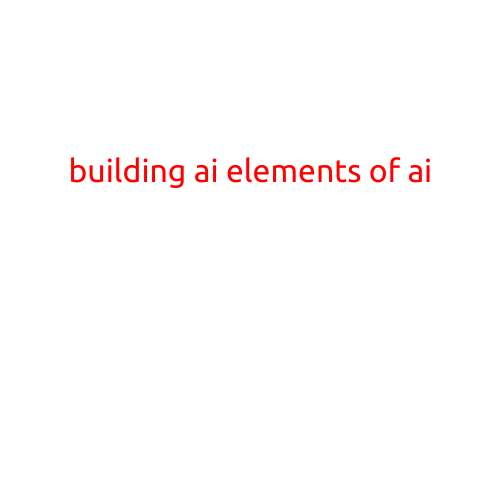
Building AI: The Elements of Artificial Intelligence
Artificial Intelligence (AI) has revolutionized the way we live, work, and interact with technology. From virtual assistants like Siri and Alexa to self-driving cars and medical diagnostic tools, AI has become an integral part of our daily lives. But have you ever wondered how AI is built? In this article, we’ll delve into the fascinating world of AI and explore the key elements that make it possible.
1. Machine Learning: The Brain Behind AI
Machine Learning (ML) is the cornerstone of AI. It’s a subset of AI that enables machines to learn from data, improve their performance over time, and make predictions or decisions without being explicitly programmed. There are three main types of ML:
- Supervised Learning: The machine is trained on labeled data to learn a specific task or pattern.
- Unsupervised Learning: The machine discovers patterns or relationships in unlabeled data.
- Reinforcement Learning: The machine learns by interacting with an environment and receiving rewards or penalties.
2. Natural Language Processing (NLP): The Ability to Understand Human Language
NLP is a subfield of AI that focuses on enabling computers to understand, interpret, and generate human language. This is achieved through various techniques, including:
- Tokenization: Breaking down text into individual words or tokens.
- Part-of-Speech (POS) Tagging: Identifying the grammatical context of each word.
- Named Entity Recognition (NER): Identifying specific entities such as names, locations, and organizations.
3. Computer Vision: The Ability to See and Understand Visual Data
Computer Vision is another essential element of AI that enables machines to interpret and understand visual data from images and videos. This is achieved through various techniques, including:
- Image Processing: Enhancing, filtering, and transforming images.
- Object Detection: Identifying specific objects within images.
- Image segmentation: Dividing images into regions of interest.
4. Robotics: The Ability to Interact with Physical World
Robotics is the field of AI that focuses on developing machines that can interact with the physical world. This includes:
- Robot Control Systems: Enabling robots to navigate and perform tasks.
- Sensor Integration: Integrating sensors to perceive and respond to the environment.
- Autonomy: Enabling robots to operate independently and make decisions.
5. Data and Analytics: The Fuel for AI Systems
Data is the lifeblood of AI systems. It’s used to train and test algorithms, and to validate the accuracy of the results. Analytics plays a crucial role in extracting insights from data, identifying patterns, and making predictions.
6. Hardware and Infrastructure: The Foundations of AI Systems
AI systems require specialized hardware and infrastructure to function efficiently. This includes:
- GPU Acceleration: Using Graphics Processing Units (GPUs) to accelerate computations.
- Cloud Computing: Utilizing cloud infrastructure to scale and deploy AI systems.
- Big Data Storage: Storing large amounts of data efficiently and securely.
The Future of AI
As AI continues to evolve, we can expect to see even more sophisticated applications in various industries, including healthcare, finance, and education. The key to unlocking the full potential of AI lies in the continued development of these essential elements:
- Machine Learning: Expanding its capabilities to tackle complex tasks and domains.
- NLP and Computer Vision: Improving their accuracy and interpretability.
- Robotics: Enhancing its autonomy and adaptability.
- Data and Analytics: Developing new techniques for data analysis and visualization.
- Hardware and Infrastructure: Advancing the development of specialized hardware and infrastructure.
In conclusion, building AI requires a deep understanding of the underlying elements that make it possible. From Machine Learning and NLP to Computer Vision and Robotics, each element plays a crucial role in enabling AI systems to learn, reason, and interact with the world. As AI continues to evolve, it’s essential to stay up-to-date with the latest advancements and applications in this rapidly changing field.





